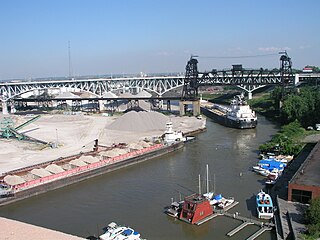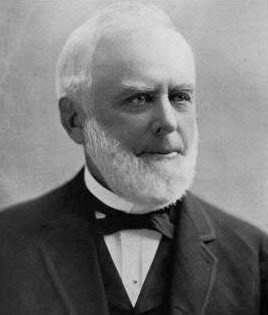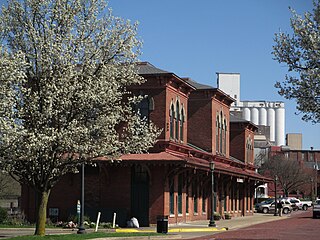Early history

The region was previously inhabited by various tribes of American Indians including the Mound Builders for an unknown period of time. There is no record of any type of settlement in the area, but it was located near Native settlements in what is now Silver Lake and Cuyahoga Falls. [1] It is believed a large rock in the Cuyahoga River, known today as Standing Rock, served as a place of council for these early tribes. Several trails crossed the area well before the arrival of European settlers. [2] Around 1780 the Indian fighter Captain Samuel Brady achieved notoriety for his activities in the area, including his famous 21-foot (6.4 m) leap over the Cuyahoga River to avoid capture, known as Brady's Leap. [3] After leaping the river, he hid in a nearby lake which was later named for him, Brady Lake. [4]
Settlement
European settlement of the area began in the late 1790s and early 19th century. As part of the Connecticut Western Reserve, the area was divided into survey townships in 1798 and almost all of what is now Kent was originally part of Town 3 Range 9, which would eventually be known as Franklin Township. [5] [6] Aaron Olmsted, a wealthy Connecticut merchant, had purchased the 16,000-acre (6,500 ha) township for $2,000 (approximately $30,000 present-day) and named it for his son Aaron Franklin. [7] Franklin Township was surveyed in 1803, and settled in November 1805 by John Haymaker, his wife Sally, and children Jacob, Eve, and Catherine. They initially lived in the former hut of the surveying team before settling on the banks of the Cuyahoga River in early 1806 and building a gristmill in 1807. [8] That same year, Portage County was formed and Franklin Township was made part of the new county. Olmsted had hoped to have Franklin become the county seat of the new county and had land set aside in what is now northern Kent for the county government buildings. He died before he could donate the land and his heirs used it for other purposes. Neighboring Ravenna ended up becoming the county seat instead. [9]

Initial growth in the area was slow, but eventually two small villages would develop due to the potential power generated by the Cuyahoga River that could be used in gristmills and manufacturing. Originally, there were two waterfalls in what is today downtown Kent, one of seventeen feet and another of twenty-five feet. [10] The first village, known as Franklin Mills or locally as the "Lower Village," developed mostly around the original Haymaker property. In 1811 Jacob Reed purchased the Haymaker mill and the settlement was known briefly as Reedsburg until Reed sold the mill in 1817 and the name of Franklin Mills was restored. [9] In 1818 Joshua Woodard arrived in the area and began constructing buildings just north of the village forming the "Upper Village" that would come to be known as Carthage. [11] The two villages would become rivals for a time due to their close proximity to one another and the competing taverns which operated in them: the Woodard Tavern in Carthage and the Lincoln Tavern in Franklin Mills. By the time the Pennsylvania and Ohio Canal opened in 1840 and the construction of what is today downtown Kent was completed, the rivalry had effectively ended as did the distinction between the two villages. [12] Today, the site of Carthage is a residential and commercial area on Kent's near west side and is found in the name of the side street Carthage Avenue in the same area. [13]
Canal era


In the 1820s and early 1830s, plans were drawn up for the Pennsylvania and Ohio Canal, which would connect Pittsburgh, Pennsylvania and Cleveland, Ohio via Akron, Ohio. Franklin Mills was selected as part of the route and due to the rocky gorge of the Cuyahoga River, construction of a lock and dam was necessitated. When construction began on the Pennsylvania and Ohio Canal in the 1830s, land speculation was rampant in many areas of northeast Ohio along the canal, including Franklin Mills. As a result of this, an industrial and business region was established along the river in what is now downtown Kent. Factories and mills were either planned or constructed along the Cuyahoga River, some of which either were never built or ultimately failed, due mostly to effects of the Panic of 1837. [14] Much of the canal bed is still visible in downtown Kent, including the historic lock and arch dam (first built in 1836), which is the only known arch dam attached to a canal lock in the United States [15] and is listed on the National Register of Historic Places. In addition, an aqueduct of the canal is still visible in southern Kent where it crossed Plum Creek. The era of the canal would be relatively short-lived, lasting into the 1860s. By 1870 the canal was completely shut down.
In the era leading up to the American Civil War, Franklin Mills was an active stop on the Underground Railroad, giving fugitive slaves shelter on their escape to Canada. Notable stops in Franklin Mills included the Cuyahoga House at the northwest corner of Cuyahoga Street and North Mantua Street (torn down in 1907), the Woodard Tavern [16] at the southwest corner of Fairchild Avenue and North Mantua Street, [17] and the Woodard house along Fairchild Avenue, which still stands today. [18] During this period, in 1835, noted American abolitionist John Brown moved to the village, operating a tannery along the Cuyahoga River with Zenas Kent, leaving in 1839. Today, a park is on the site of the tannery, which was torn down in 1976 as part of an environmental reclamation project of the areas around the Cuyahoga River. [19] On June 26, 2004, an historical marker was dedicated in downtown Kent commemorating the city's role in the Underground Railroad. [20]
Railroad era

In 1863, a local businessman by the name of Marvin Kent was influential in bringing the Atlantic and Great Western Railroad through the village. The railroad reinvented the village as an important stop on the east-west line between St. Louis and New York City as it was also home to the railroad's maintenance yards and shops. To honor Marvin Kent the village was renamed Kent in 1864, although this change was not official until the village was incorporated on May 6, 1867. [21] Originally, before naming the city after Marvin Kent, city leaders including Marvin Kent were also considering the name Rockton, a name which Marvin Kent actually preferred, [22] (hence the name of the Masonic Lodge as Rockton Lodge) after Standing Rock. [23]

John Davey came to Kent in 1881 as head grounds keeper at Standing Rock Cemetery, planting several trees and landscaping the cemetery as well as performing experiments on trees. In 1901 he published his theories on tree surgery with his book The Tree Doctor and later established the Davey Tree Expert Company in 1909, [24] which led to Kent becoming known as "The Tree City." On February 15, 1949, Kent was officially proclaimed "The Tree City of Ohio" by a resolution [25] and has been designated as a Tree City USA for over 20 years. [26] The city's official emblem features a tree logo and can be found on Kent's street signs and other city signs and offices.




















